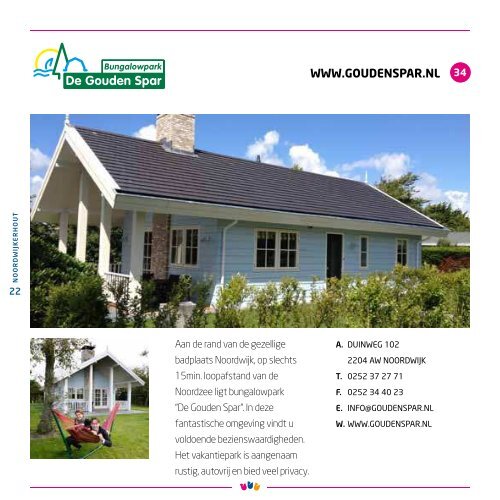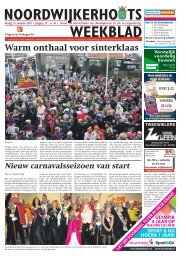Evenementenboekje 2013 - NOV Noordwijkerhoutse ...
Evenementenboekje 2013 - NOV Noordwijkerhoutse ...
Evenementenboekje 2013 - NOV Noordwijkerhoutse ...
You also want an ePaper? Increase the reach of your titles
YUMPU automatically turns print PDFs into web optimized ePapers that Google loves.
Noordwijkerhout<br />
22<br />
Aan de rand van de gezellige<br />
badplaats Noordwijk, op slechts<br />
15min. loopafstand van de<br />
Noordzee ligt bungalowpark<br />
“De Gouden Spar”. In deze<br />
fantastische omgeving vindt u<br />
voldoende bezienswaardigheden.<br />
Het vakantiepark is aangenaam<br />
rustig, autovrij en bied veel privacy.<br />
-<br />
Toeristisch P latform<br />
Noordwijkerhout<br />
WWW.goudenspar.nl<br />
A. DUiNwEG 102<br />
2204 aw NOORDwijK<br />
t. 0252 37 27 71<br />
F. 0252 34 40 23<br />
e. iNfO@GOUDENSPaR.NL<br />
w. www.GOUDENSPaR.NL<br />
34<br />
42<br />
a brief history of noordwijkerhout<br />
Long before recorded time, a Germanic tribe settled in the<br />
narrow sandy strip between the North Sea and the marshy<br />
hinterland, later on known as “Caninefates” by the Romans.<br />
They lived in the area that is now the Langeveld Nature<br />
Reserve near Noordwijkerhout.All history has been lost until<br />
the late 9th century, when the area then known as Northgo<br />
was part of the Lorraine kingdom, reigned over by count<br />
Gerlof. Still later, Northgo was divided into a southern region<br />
(Noordwijk) and a northern region (Noordwijkerhout). One<br />
of the earliest remaining buildings of Noordwijkerhout is<br />
the picturesque white church in the town centre that dates<br />
back to the year 1300. The village slowly expanded from<br />
that period on and by the mid-18th century, there were<br />
124 households and a corn-mill surrounding the church. For<br />
the commoner of those times, life in Noordwijkerhout was<br />
a constant struggle. People existed on agriculture, livestock<br />
and fishery. Vegetable growers were incessantly plagued by<br />
rabbits, introduced by the landowners for hunting. As poaching<br />
was severely punishable, the locals resorted to selling<br />
seashells and debris from the beach as extra income. Only in<br />
the 20th century did the area change in prosperity. Ancient<br />
inland sand dunes were excavated to build roads, railways and<br />
to expand cities. Around Noordwijkerhout, the centre of which<br />
still lies on such a dune, you can still clearly see just how much<br />
sand was removed. The underlying soil proved to be ideal for<br />
growing flower bulbs and has become a flourishing business<br />
and a beautiful springtime tourist attraction. Noordwijkerhout<br />
really is “the Heart of the Tulip Fields”.<br />
You can find more information about the history of<br />
Noordwijkerhout on the council website www.noordwijkerhout.nl<br />
-<br />
Toeristisch P latform<br />
Noordwijkerhout<br />
die geschichte von noordwijkerhout<br />
Weit vor unserer Zeitrechnung bewohnte ein Germanischer<br />
Stamm einen schmalen Landstreifen zwischen der Nordsee<br />
und dem morastigen Hinterland. Ihr Lebensgebiet war dort,<br />
wo heute das Naturgebiet Langeveld ist. Später nannten die<br />
Römer die Bewohner „Caninefaten“. Erst im Mittelalter taucht<br />
Noordwijkerhout wieder in den Geschichtsbüchern auf. Im 9ten<br />
Jahrhundert gehörte Northgo – wie das Gebiet damals hieß,<br />
dem Reich von König von Lothringen an. Von ihm bekam Graf<br />
Gerolf im Jahr 889 Northogo als Lehn Wieder später wurde<br />
Northgo aufgeteilt in einen südlichen Teil (später Noordwijk)<br />
und einen nördlichen Teil (später Noordwijkerhout). Einen der<br />
ältesten bestehende Gebäude, “de Witte Kerk”, wurde um das<br />
Jahr 1300 gebaut. Im Jahr 1500 standen ca. 50 bis 60 Häuser<br />
um die Kirche. Mitte des 18ten Jahrhunderts war das Dorf auf<br />
124 Häuser und eine Kornmühle gewachsen. Das Leben in<br />
dieser Gegend war damals nicht leicht. Die Menschen lebten<br />
meist von der Landwirtschaft, Viehzucht und Fischerei.<br />
In den Wintermonaten brachte auch Strandgut und<br />
Muschelfischen noch ein kleines Nebeneinkommen. Aber<br />
viel Wohlstand kannte man nicht. Erst im zwanzigsten<br />
Jahrhundert kamen große Veränderungen. Die Dünen und<br />
Brandungssandwalle wurden abgegraben und das Sand<br />
wurde für den Bau von StraBen und Eisenbahnen und<br />
Stadterweiterung verwendet. In der nähe von Noordwijkerhout,<br />
dessen Zentrum immer noch auf einem Strandwalle liegt,<br />
ist es leicht zu sehen, wie viel Sand abgegraben ist. Der<br />
Boden erwies sich eine ideale Boden für den Anbau von<br />
Blumenzwiebeln.<br />
So ist den Anbau mehr und mehr geworden. Mehr Geschichte<br />
finden Sie auf www.noordwijkerhout.nl.<br />
Noordwijkerhout<br />
23



